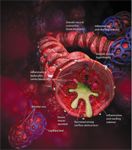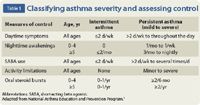Uncontrolled asthma: When to step up therapy
Asthma is a chronic inflammatory disorder of the airways characterized by bronchoconstriction, airway hyperresponsiveness, airway edema, and inflammation leading to reversible airflow obstruction.

Key Points

A recent survey of pediatric patients with asthma visiting their primary care providers for any medical reason found a 46% prevalence of uncontrolled asthma.2 Poorly controlled asthma has a significant cost to families and society related to doctor and emergency department visits, hospitalizations, and missed work and school. Children with poorly controlled asthma also have lower health-related quality-of-life scores than children whose asthma is well controlled.3
Goals of asthma therapy
Assessing asthma severity and control
At each asthma visit it is important to assess asthma control, medication technique, medication adherence, and patient and parent concerns.1 Reliable assessment of symptoms is necessary to determine the optimal therapy to control a patient's asthma. The measures used to classify asthma severity and control include frequency of day and nighttime symptoms, frequency of rescue short-acting beta agonist (SABA) use, degree of activity limitation, and frequency of asthma exacerbations requiring oral steroid bursts (Table 1).1

Assessing asthma control can be difficult, especially in young children, because much of it relies on self-report. Spirometry and validated questionnaires such as the Childhood Asthma Control Test (C-ACT) can assist in the assessment of asthma control.4 Following FEV1 (forced expiratory volume in the first second) and FEV1/FVC (forced vital capacity) is more reliable than following peak expiratory flows. The C-ACT is a self-administered test that assesses asthma control in children aged 4 to 11 years. A score of 19 or less has good reliability in indicating uncontrolled asthma.
Optimal asthma medication delivery is an important component of achieving good asthma control. A metered-dose inhaler (MDI) with a valved holding chamber, or spacer, and with a mouthpiece offers the most efficient means of delivering asthma medication to the lungs. For infants and uncooperative children, a spacer with a tight-sealing face mask can be used.5
Nebulizers are less reliable in their delivery of the medication to the lungs and less effective than an MDI with a spacer in acutely wheezy children.6
Breath-actuated, pressurized MDIs and dry powder inhalers require a certain degree of coordination and inspiratory force; their use should be restricted to children at least 6 years old. Because all the delivery devices have their limitations, the most important factor is addressing parent and child preferences and choosing a delivery device that they are comfortable with and will use.